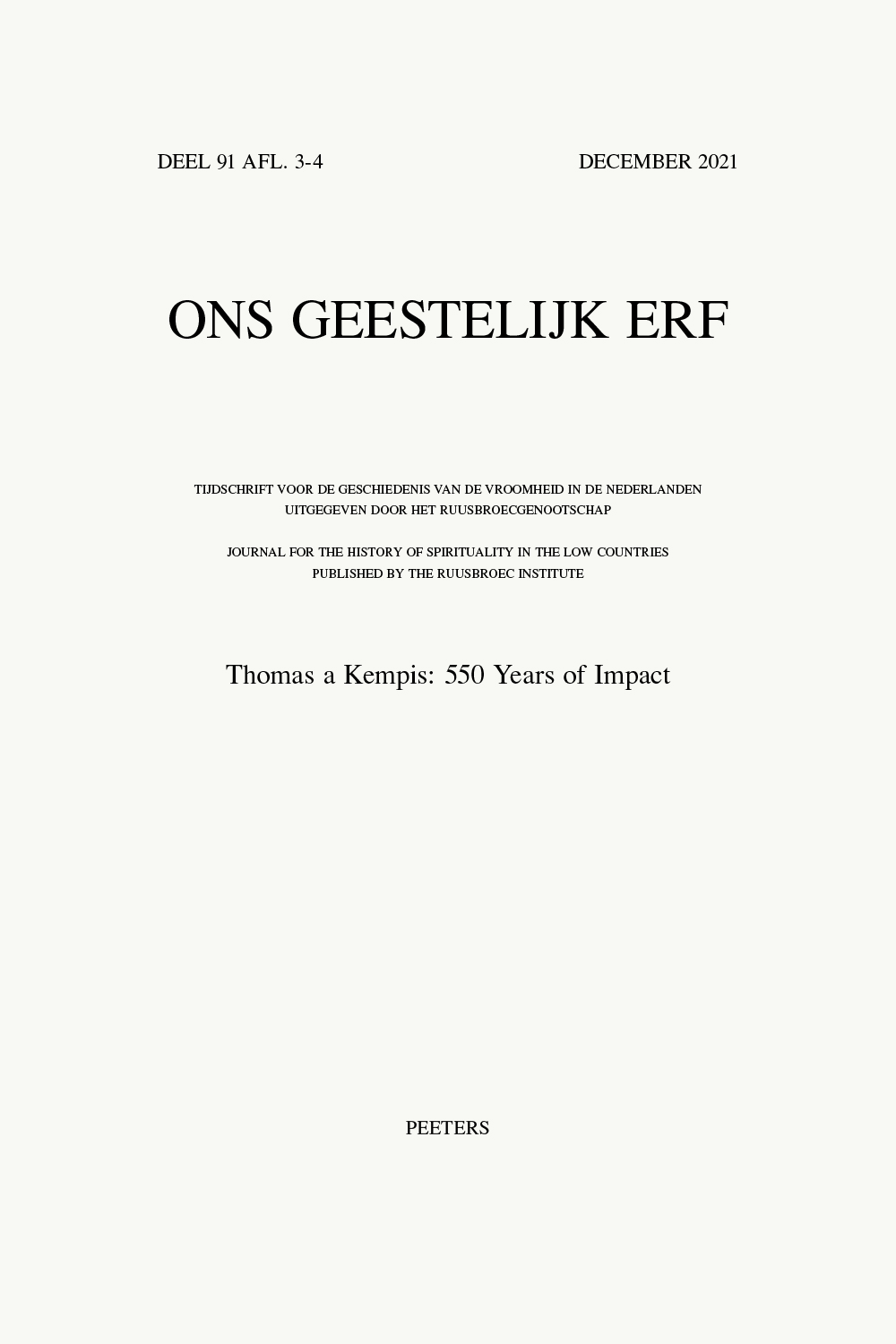next article in this issue  |

Preview first page |
Document Details : Title: Dwaalwegen Subtitle: Recente hypotheses over Hadewijchs biografie Author(s): WILLAERT, Frank Journal: Ons Geestelijk Erf Volume: 84 Issue: 2-3 Date: Juni-September 2013 Pages: 153-194 DOI: 10.2143/OGE.84.2.3005439 Abstract : This article aims at refuting four recent, mutually incompatible hypotheses concerning Hadewijch’s biography. 1. According to Wybren Scheepsma, Hadewijch’s work should not be dated before the end of the 13th century. Hadewijch might even be identical with the beguine Heilwijch Bloemaerts († 1336), who in her turn is often identified with the heretic Bloemardinne, mentioned in Ruusbroec’s hagiography by Pomerius. Scheepsma’s reasoning cannot, however, stand the test of criticism. 1. It is not correct to discredit Van Mierlo’s arguments in favour of an earlier dating of Hadewijch by relating them to his Roman Catholic convictions or his sympathy for the Flemish Movement. 2. There is philological evidence that the Limburg sermons of the end of the 13th century contain adaptations of some of Hadewijch’s letters, and not the other way round. 3. There is no reason to assume that a female author around the middle of the thirteenth century was unable to have a command of Latin great enough to translate a passage from pseudo-Richard of Saint-Victor’s Expositio in Canticum Canticorum by herself and that Hadewijch’s 10th Letter must, consequently, be attributed to a cleric. 4. There is no reason to throw doubt on Hadewijch’s List of the Perfect as a valuable source for dating her work. 5. Hadewijch’s use of forms and melodies of French trouvère songs very well fits a dating of her poetry around or shortly after the middle of the thirteenth century. Scheepsma’s proposition that Hadewijch must have lived and worked in Brussels – which would make her identification with Heilwijch Bloemaerts more plausible – is equally built on sandy ground. The fact that some 14th century manuscripts did indeed originate in or around Brussels, does not allow us to situate her in that city with any certainty. 2. According to Rob Faesen, Hadewijch may, at a certain moment of her life, have become the first abbess of the Cistercian abbey of Valduc, which was founded in or soon after 1230. The arguments invoked by Faesen to make Hadewijch into a Cistercian nun, however, are unconvincing. From the first lines of Vision 9, one cannot deduce that Hadewijch must have experienced that vision in a convent church; her acquaintanceship with Cistercian spirituality does not necessarily imply that she must have belonged to that order; the repetition of the word clare (‘clear’) in the opening sentence of her first Letter need not be interpreted as an allusion to the name Claravallis, but is inspired by chapter 17 of the gospel by Saint John; the fact that in her first Vision, she speaks of ‘a Sunday in the Octave of Pentecost’, and not of ‘Trinity Sunday’, does not necessarily imply that she lived in the diocese of Liège; and taking into account what she says about a certain Margaret in her 25th Letter, one cannot easily imagine that this woman is to be identified with Duke Henry II’s youngest daughter of the same name, who seems to have entered Valduc soon after its foundation. 3. In his turn, Hans Wilbrink posits that Hadewijch should be identified with Hawidis, a recluse of Saint Remacle near Liège, who makes a fleeting appearance in the Life of Juliana of Cornillon. The mere fact that Liège was, also at that time, a French-speaking city, makes the idea that Hadewijch wrote her Middle Dutch works on the Romance side of the linguistic border rather unlikely. The same can be said of the numerous other arguments, which Wilbrink adduces in favour of his hypothesis. 4. Finally, there is no reason to accept Daniel Devreese’s identification of Hadewijch with a certain Hadewid Greca of Merksem, who turns up in a record, now lost, written between 1210 and 1213. As a matter of fact, this record is only known through an edition, based on an unreliable and incomplete transcript, which has equally gone lost. The reading Greca in particular, which plays a central role in Devreese’s attempt to relate Hadewijch to the beguines of Zoutleeuw, is very doubtful. Besides, Devreese’s argument that Hadewijch, in her List of the Perfect, has enumerated her dead contemporaries in an order that is strictly chronological, seems rather strained. Equally unconvincing is P.C. Boeren’s view, adopted by Devreese, that herren Heynrecke van Breda, mentioned by Hadewijch, cannot be identical with lord Hendrik IV of Breda, who reigned between 1246 and 1254. Our final conclusion can only be that for the time being, there is no reason to abandon the traditional view, mainly formulated by Jozef van Mierlo, according to which Hadewijch must have been a beguine, who lived in the duchy of Brabant in the middle of the thirteenth century. |
|


